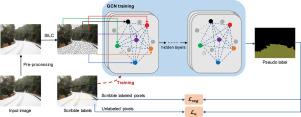Weakly-supervised road condition detection via scribble annotations
IF 3.1
4区 计算机科学
Q2 COMPUTER SCIENCE, INFORMATION SYSTEMS
Journal of Visual Communication and Image Representation
Pub Date : 2025-06-07
DOI:10.1016/j.jvcir.2025.104494
引用次数: 0
Abstract
Deep learning-based solutions in road condition detection rely on fully supervised learning widely which requires a large quantity of training data with pixel-wise annotation from researchers. Accurate dense labeling is challenging since the boundaries between road condition regions are ambiguous. To combat this issue, this work aims to introduce a weakly supervised road condition detection framework, which can generate high-quality pseudo masks from sparse scribble labels and train a road condition detection network using these masks. Specifically, we collect a dataset for road condition detection and annotate it with scribble. Next, we propose a graph convolutional network (GCN)-based label augmentation strategy, which considers both local and global image information, to generate pixel-level pseudo-labels by augmenting the label information from scribbles to the whole. To alleviate the label inconsistency caused by sparse annotations, we adopt the supervision strategy with joint loss of labeled and unlabeled regions during training. Extensive experiments demonstrate that the proposed method can work well on various road condition detection and is on par with the full-supervision method. The code will be made publicly available at https://github.com/qinhs9/Scribble_road_Condition.

通过潦草注释进行的弱监督路况检测
基于深度学习的路况检测解决方案广泛依赖于完全监督学习,这需要大量的训练数据和研究人员的逐像素注释。由于道路状况区域之间的边界是模糊的,因此精确的密集标记是具有挑战性的。为了解决这个问题,本工作旨在引入一个弱监督路况检测框架,该框架可以从稀疏的涂鸦标签生成高质量的伪掩码,并使用这些掩码训练路况检测网络。具体来说,我们收集了一个用于道路状况检测的数据集,并用涂鸦对其进行注释。接下来,我们提出了一种基于图卷积网络(GCN)的标签增强策略,该策略同时考虑了局部和全局图像信息,通过将标签信息从涂鸦扩展到整体来生成像素级伪标签。为了缓解稀疏标注导致的标签不一致,我们在训练过程中采用了标注区域和未标注区域联合损失的监督策略。大量的实验表明,该方法可以很好地用于各种路况检测,与全监督方法相当。该代码将在https://github.com/qinhs9/Scribble_road_Condition上公开发布。
本文章由计算机程序翻译,如有差异,请以英文原文为准。
求助全文
约1分钟内获得全文
求助全文
来源期刊

Journal of Visual Communication and Image Representation
工程技术-计算机:软件工程
CiteScore
5.40
自引率
11.50%
发文量
188
审稿时长
9.9 months
期刊介绍:
The Journal of Visual Communication and Image Representation publishes papers on state-of-the-art visual communication and image representation, with emphasis on novel technologies and theoretical work in this multidisciplinary area of pure and applied research. The field of visual communication and image representation is considered in its broadest sense and covers both digital and analog aspects as well as processing and communication in biological visual systems.
 求助内容:
求助内容: 应助结果提醒方式:
应助结果提醒方式:


